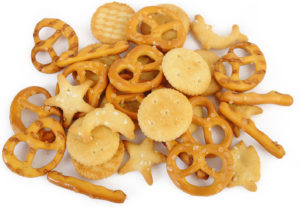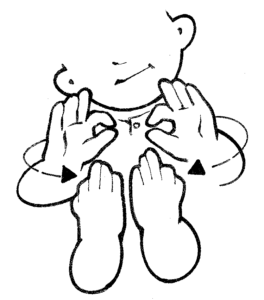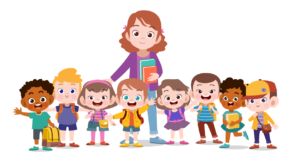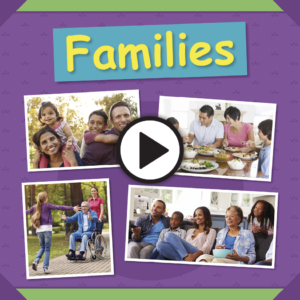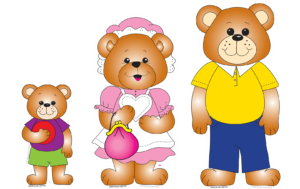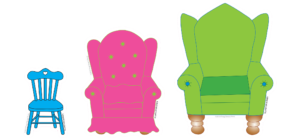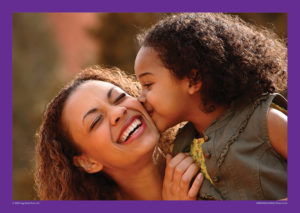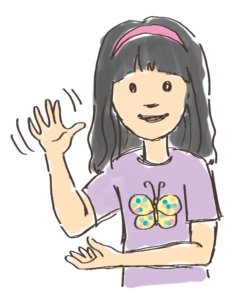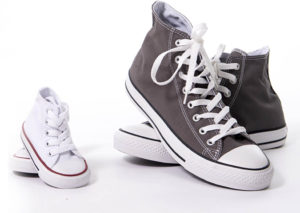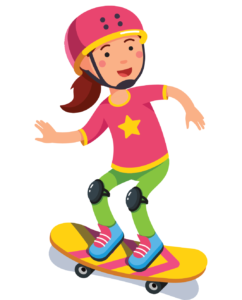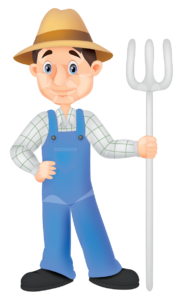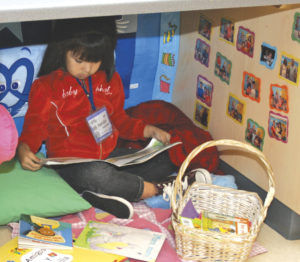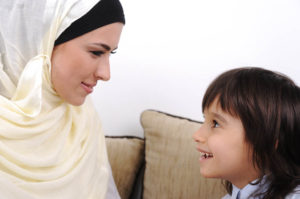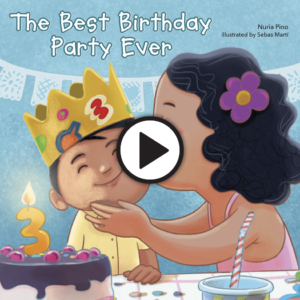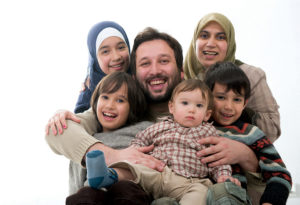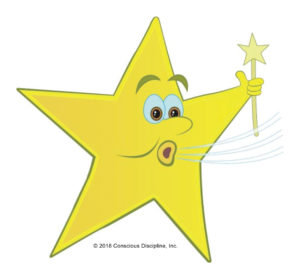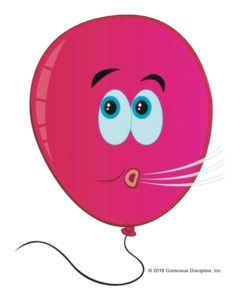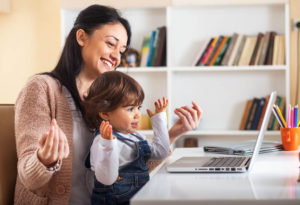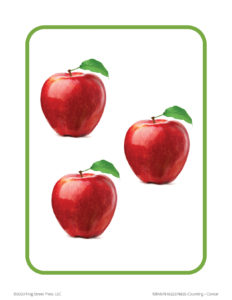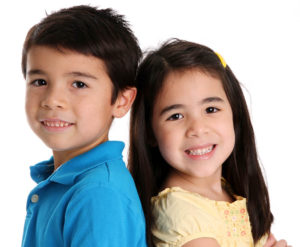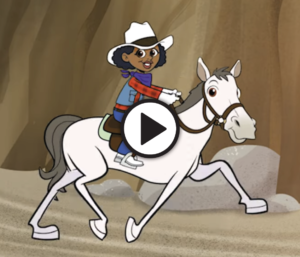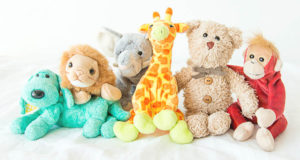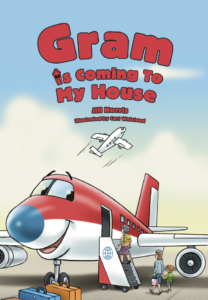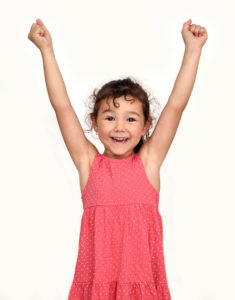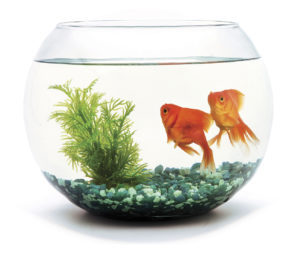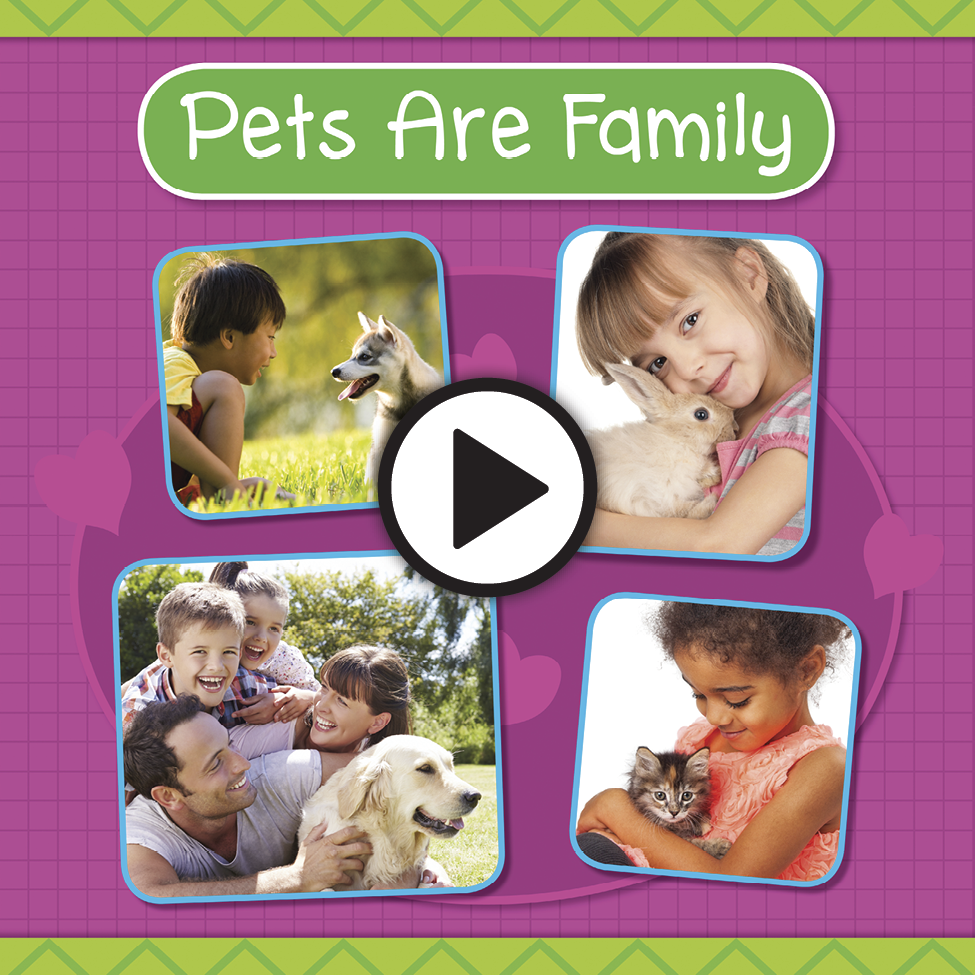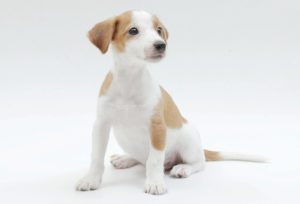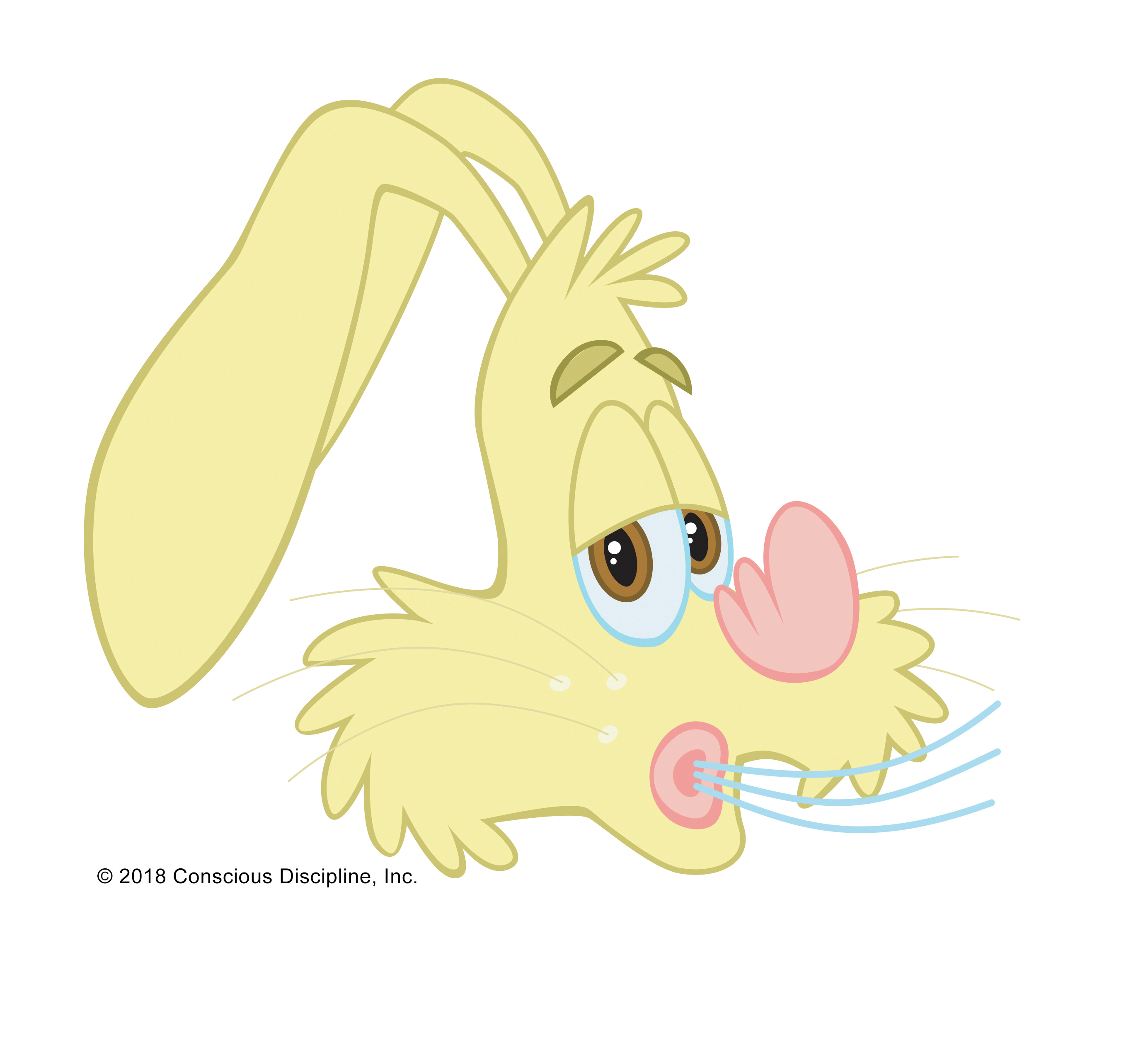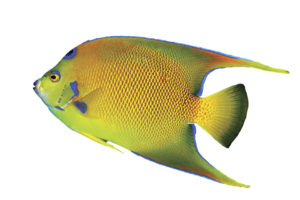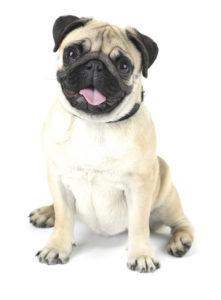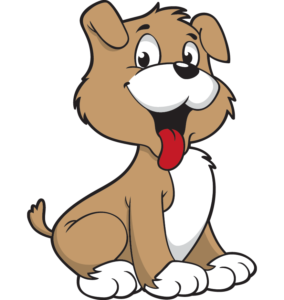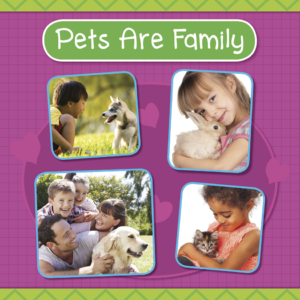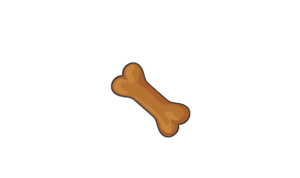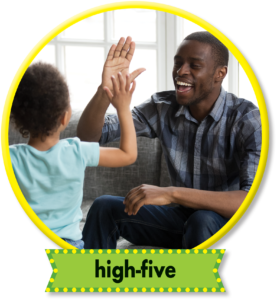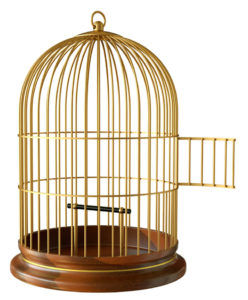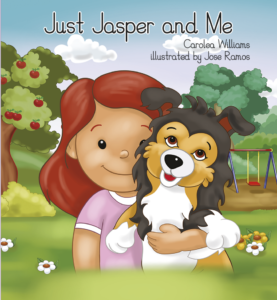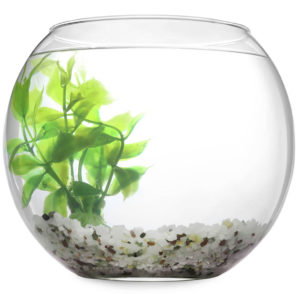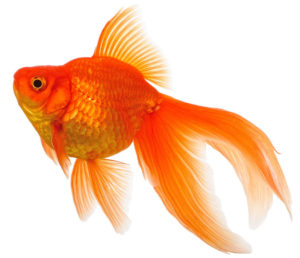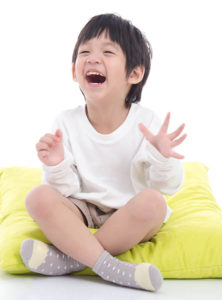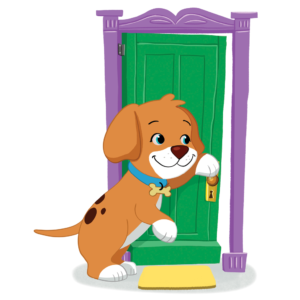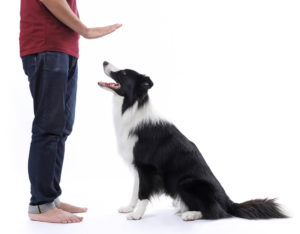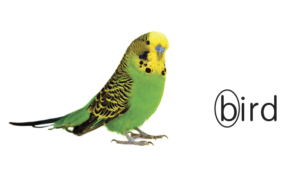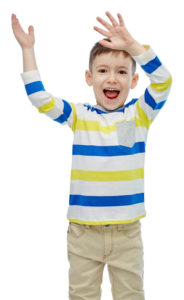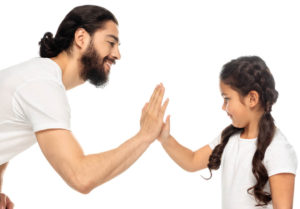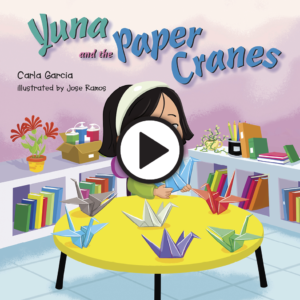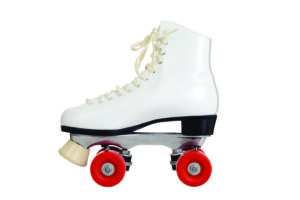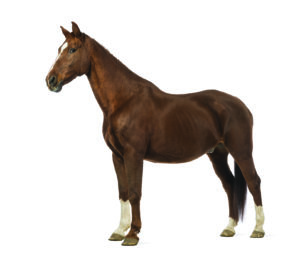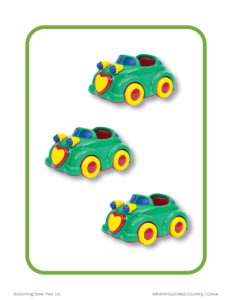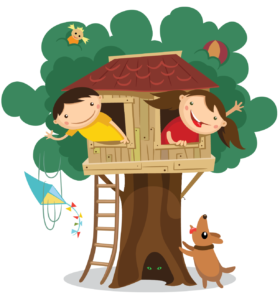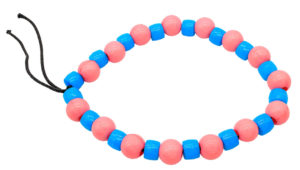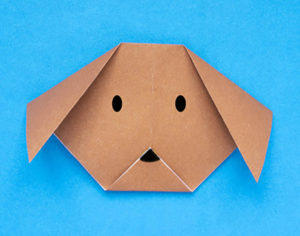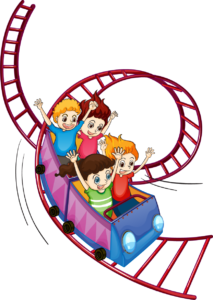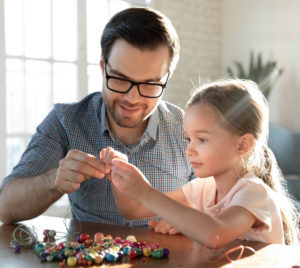My Family and Friends
Week 1: My Family
This week, your child will learn about many different kinds and sizes of families. You will explore how families work and play together and how families can be alike and different. You will have lots of fun discovering how fabulous families can be!
Word of the Week: fabulous
Before You Begin
Watch this video to better understand the concepts your child will be learning this week. This is not a video you will watch with your child. This is just for you!
Supplies to Gather
- belts (various sizes and lengths)
- blanket
- coins
- family photo
- journal
- paint
- paper
- play dough
- scissors
- straws
- tape
- writing tools (crayons, markers, pens, pencils)
Daily Message
My family is fabulous.
- Say the sentence. (Do not write it.) Ask your child to repeat the sentence.
- Hold up one finger for each word. Ask: How many words in the sentence?
- Write the sentence one word at a time. When you finish the first word, say: I leave a space before I write the next word.
- Read the sentence and count the words in the sentence.
Storytime
Watch the read-aloud video Families with your child. Tell your child that this is an informational book (nonfiction). This means the book has true facts in it instead of a make-believe story.
Small and Big Sort
Work together with your child to do a household chore that includes sorting by size. For example, when sorting laundry, invite your child to make a pile of big socks and a pile of small socks or sort clean spoons as you put them away (big spoons and small spoons).
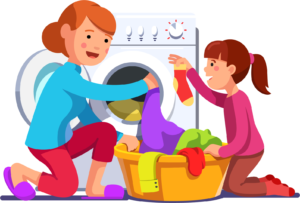
Get Across the Room
Toss a coin to determine how big a step forward your child should take to get across the room one step at a time.
heads: one BIG step forward
tails: one tiny step forward
Continue tossing the coin until your child makes it across the room. Count and keep track of how many steps it takes.
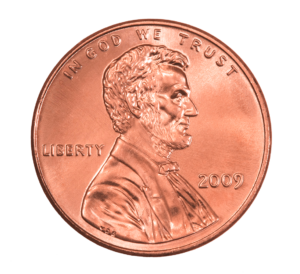
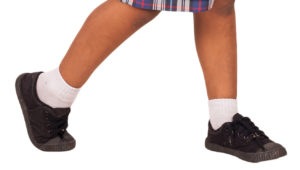
How Can You Help?
Tell your child that everyone in a family helps with daily chores. Doing jobs is one way that families take care of each other. Show your child how to do two possible tasks. Ask: What job will you do today? Thank your child for helping.
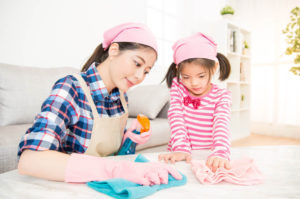
Daily Message
Families work together.
- Say the sentence. Ask your child to repeat it.
- Knock on the table for each word. Ask: How many times did we knock?
- Write the sentence one word at a time. Leave a space between each word.
- Move your hand under (track) the words as you read the sentence aloud.
- Have your child count the number of words in the sentence.
Someone’s Knocking
Play this listening game. Say: Someone’s knocking on the door. Ask your child to say the sentence with you. Knock on a door for each word in the sentence. Ask: How many times did we knock? Repeat for other sentences. Knock and count words.
- Mom is at work.
- Dad is making soup for lunch.
- Will you sing with me?
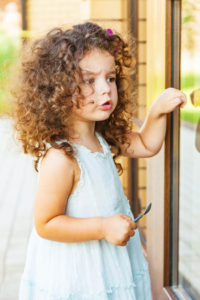
Storytime
Show Families and remind your child that this week you are learning about families. Turn to the title page and have your child name the members of the family in the photo. Look at other pages to compare families. Have your child use markers to draw each member of your family. Label the drawings with family member names.
Compare Sizes
Name an object (such as a car). Toss a penny. If it lands heads up, ask your child to name an object that is bigger than a car. If the penny lands tails up, ask your child to name an object that is smaller than a car. Repeat the game using other objects (dog, apple).
Which is smaller?
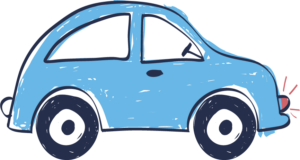
Which is bigger?
“Just Right” Chair
Help your child search for three chairs in the house. Search for a hard chair, a soft chair, and one that is just right. Ask these questions: Why do you think this chair is hard (soft)? What is this chair made of? Why do you think this chair is just right?
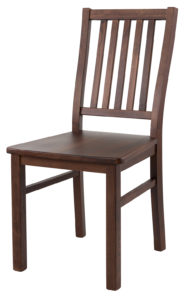
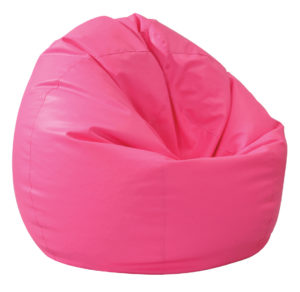
Sort Coins
Explain that sorting is a way to group or organize objects. Have your child sort a pile of coins. Make two piles—a pile of big coins and a pile of small coins. Ask: Which pile do you think has more coins in it? How can we tell for sure?
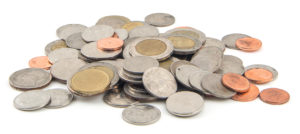
Wish You Well
Talk about some friends and family members you and your child like to visit. Form a heart with your hands and chant these words together.
We wish you well.
We wish you well.
All through the day
We wish you well.

Daily Message
Families play together.
- Read the sentence and knock on the table for each word.
- Ask your child to repeat the sentence one word at a time as you write each word.
- Place a finger after each word to make a space between words as you write them.
- Read the sentence together as you point to each word.
- Ask: How does our family play together?
Writing Together
Talk with your child about jobs that family members do at their work. Together say a sentence about each family member, such as Mom teaches school. Write the sentence as you repeat it aloud. When you have talked about each family member, go back and read all the sentences.

Storytime
Watch the read-aloud video Families with your child. After watching the video, recall with your child some ways families in the book played together. Ask: What is your favorite kind of family play?
Sort Writing Tools
Together with your child, gather a collection of writing tools (markers, pencils, pens, crayons) from around your house. Ask your child to pick a favorite from the collection. Then have your child sort all other writing tools into two groups: longer than the favorite, shorter than the favorite. Ask: What will we do if a writing tool is the same length as your favorite?
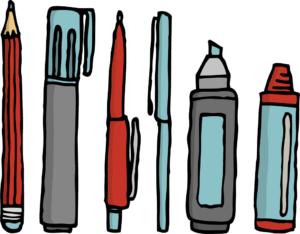
Compare Names
Write your first name on a sheet of paper and your child’s first name directly below. Have your child compare the names. Ask: Are the names the same length? Which name is longer (shorter)? How many letters are in each name? Which name has the most (fewest) letters?

Sturdy Chair
Ask your child: What if we had no chairs in our house? What else could we use to sit on? Have your child find an object around the house that is sturdy (doesn’t break or squash when you sit on it) and is safe. Ask: What makes __________ sturdy and safe to sit on?
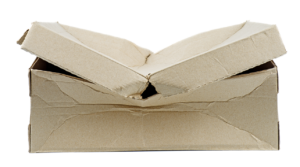
Not sturdy
Build a Family
Have your child create a shape family using different-sized blocks and boxes, or cut-out paper shapes. When the family is built, have your child point out the members and introduce you to them if she has given them names.
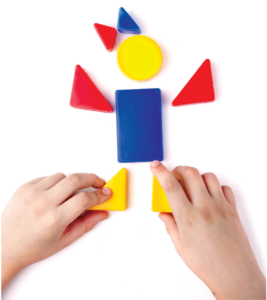
Commitments
Remind your child that at the beginning of each day, the two of you choose a specific way to keep your learning time safe. Review Listening Ears, Walking Feet, Helping Hands, and Big Voice (the four commitments you talked about last week). Ask: Which commitment would you like to focus on today?

Daily Message
Families eat together.
- Say the sentence.
- Ask your child to repeat the sentence one word at a time as you write each word.
- Place a finger after each word to make a space between words as you write them.
- Read the sentence together as you point to each word.
- Ask: What is our family’s favorite meal?
My Journal
Families eat rice in many ways: in soups, with sauce, in pudding. Ask: What is your favorite way to eat rice? Have your child draw an answer on a journal page. Ask your child to explain the drawing. Write the explanation below the drawing. Note: If your family does not eat rice, choose another food that is eaten in several different ways (beans, corn).

Storytime
You and your child have been reading Families this week. Turn to page 3 and explain the Table of Contents. You might say: Nonfiction books often have a Table of Contents. This page helps readers find information. You do not have to start reading an information book on page 1. You can read the pages in any order. Let’s choose a topic and read only about that topic today.
Measure Me
Have your child stand with her back against the wall. Place a piece of tape on the wall at the top of your child’s head. Measure your child’s height in the same way several times throughout the year.
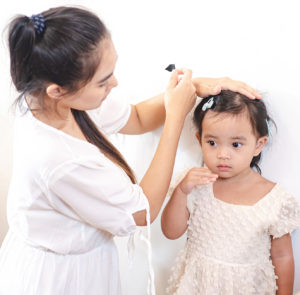
Choosing Straws
Cut six straws to different sizes. Hold the straws in your hand so they look to be all the same size. Take turns choosing straws. After each of you has chosen a straw, compare whose straw is shorter or taller. Continue until all straws have been chosen.
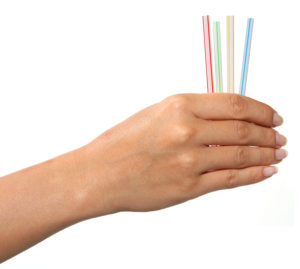
Soft Seat
Say: Today you will solve a problem. How could the seat you found yesterday be softer and more comfortable? Help your child think about ideas and then try them out. Ask: What could you do to make it softer to sit on? How can you make it so you can rest your back? (place against wall)
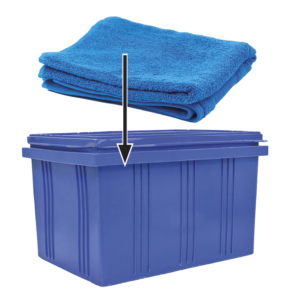
Long Cut, Short Cut
Fold two separate sheets of paper lengthwise. Unfold the sheets. Draw a cutting line along the fold. Have your child use scissors to make long cuts along one line and short cuts along the other. Ask: Is it easier to make long or short cuts with scissors? Why? Which took more cuts to reach the end of the paper?
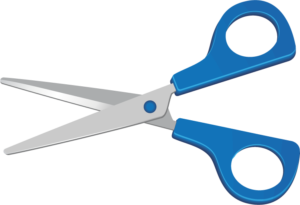
Daily Message
Families celebrate together.
- Say the sentence.
- Ask your child to repeat the sentence one word at a time as you write.
- Place a finger after each word to make a space between words as you write them.
- Read the sentence together as you point to each word.
- Ask: How does our family celebrate?
Look at Letters
Focus Letters: Ff, Gg, Mm
Have fun with your child forming this week’s letters using play dough. Notice the straight and curved lines in each letter. Have your child practice saying the name of each letter and tracing it with a finger. If your child needs help with the letter shapes, write letters on paper as a guide.
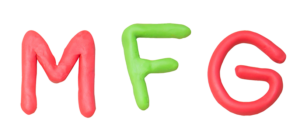
Storytime
Read Families. Pause on pages 14-17. Talk about the ways families in the book celebrate together. Ask: How are our family celebrations the same or different from the ones in the book? What is your favorite family celebration?
Sort Belts
Collect belts from different family members, both adults and children. Have your child compare and sort the belts by looking at different size attributes (long, short, wide, narrow, thick, thin). Say: Tell me about how you are sorting the belts.

Line Collage
Have your child use markers, crayons, and pencils to draw different lines and compare the line thicknesses. Ask: Which writing tools have thicker (or thinner) tips? Which lines did they make? How can you match the writing tool and the line?

Favorite Blanket
Invite your child to find a favorite blanket to cuddle up with and relax. Have your child describe the blanket. Ask: What does it look like? Is it colorful? Does it keep you warm? Is it soft? What makes it feel soft? Is it big enough to cover your body?

Family Portrait
Have your child use paint or markers and paper to draw a family portrait. Ask your child to tell you about the drawing. Help your child label the people in the drawing.
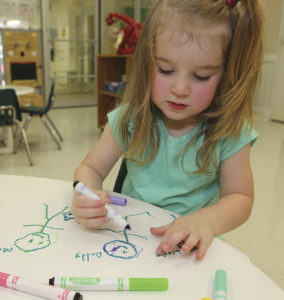
My Family and Friends
Week 2: My Relatives
This week, you will learn about family members beyond mom, dad, sisters, and brothers. You will be talking about grandmothers, grandfathers, aunts, uncles, and cousins. You and your child will explore ways relatives enjoy spending time together.
Word of the Week: relatives
Before You Begin
Watch these videos to better understand the concepts your child will be learning this week. These are not videos you will watch with your child. These are just for you!

Books to Read
- Abuela eBook
- Families eBook
- Gram Is Coming to My House eBook
- The Best Birthday Party Ever eBook
- The Best Birthday Party Ever Read-Aloud video
Supplies to Gather
- box lid
- building materials (blocks, cardboard tubes and boxes, trays)
- cell phone
- dice
- dirt
- family photos
- journal
- leaves
- napkin
- note cards
- paint
- paper
- pennies
- pillow
- plastic cup
- play dough
- small sticks
- stickers
- stuffed animals
- towel
- writing tools (crayons, markers, pens, pencils)
- yearly calendar
Listening Ears
Remind your child about Listening Ears. Provide examples by describing ways you can tell your child is listening: You are sitting still, and you are looking right at me. Your hands and feet are quiet. Say: When you use your listening ears, you are helping to keep our learning time safe.
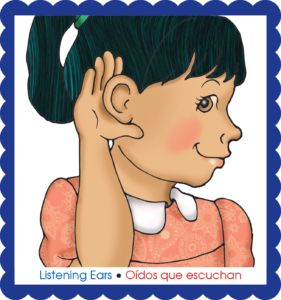
Daily Message
I travel to visit relatives.
- Say the message. Have your child repeat it.
- As you repeat the message, have your child hold up one finger for each word.
- Repeat again as you point to each finger. Ask: How many words?
- Write the message leaving a space between each word. Have your child count the written words.
Ten on the Bed
Enjoy watching and singing along with the music video “Ten on the Bed” by Don Monopoli. Ask: When might you have to sleep in a bed with many others? How would you keep yourself from rolling out of the bed?
Storytime
Watch the read-aloud video The Best Birthday Party Ever with your child. This book is a story about how a family helps plan a birthday party. Ask: Do you think this story could actually have happened? Why or why not? Think about how your family members work together to plan celebrations.
Families Big & Small
Reread pages 4-5 of Families. Have your child count and name the family members. Ask: Which family is bigger, smaller? Which has the most, least number of people? Can you tell how many family members there are without counting each person? Why, why not?
Count a Family
Learning to recognize how many are in a small set without counting is an important math skill. You and your child will practice telling how many without counting (subitizing) this week. As you talk about the photo, notice when your child can tell you how many without counting. Click image to begin.
Parts of a Tree
Go outdoors with your child and find a tree. Help your child find the parts of the tree as you name them: trunk, bark, branch, leaves, and roots. Ask: How are trees like other plants? How are they different?
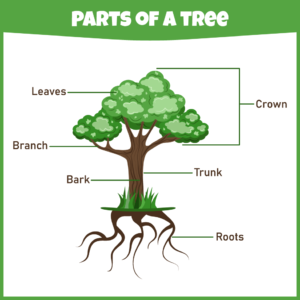
Build a House
Have your child use blocks, tubes, cardboard boxes, and trays to build a pretend house for a family. If you have a large cardboard box, provide paints and markers to decorate it. Ask: Which rooms of your house need to be large? How will you make sure there is room for relatives to stay? Note: This project may take several days.
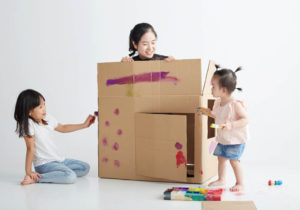
Calming Strategies
Remind your child when adults and children are calm, they are better able to control their feelings. They are more prepared to learn. Practice S.T.A.R. and Balloon. Have your child choose one strategy and lead you (and other family members) in doing it three times. Click images to review the strategies. Say: Thank you for being our S.T.A.R. leader.
Daily Message
My grandmother is a relative.
- Say the message. Have your child repeat the message tapping the words.
- Write the first word. Point to the word and “read” it together.
- Have your child recall each word as you write it leaving a space between words.
- Have your child use a relative’s name in a similar sentence: Aunt Mary is a relative.
Take It Apart
Show the cover of The Best Birthday Party Ever or another favorite book. Say the title of the book and have your children repeat the title. Take the title apart (segment it) in different ways with your child.
- Tap shoulders for each word.
- Place a blank stick-on note on the table for each word.
- Roll a toy car forward for each word.

Skidamarink
Remind your child of the song “Skidamarink.” It is a song often sung by parents to children. Practice singing the song together. Share the feelings in the lyrics by recording the song and sending it to a relative. Or perform it live together during a video call with a loved one who lives faraway. Click image for lyrics.
Storytime
Show the cover of Abuela. Abuela is the Spanish word for grandmother. Say: This imaginary story is about a grandmother and her granddaughter. Point out the characters flying in the air on the cover. People flying in the air is imaginary. Read the book together. Ask: What adventures have you had with your grandmother?
Without Counting
Invite your child to pretend to fly above the ground just like Rosalba does with her abuela in the story that you read during Storytime. Challenge your child to look down to see each set of objects. Which quantities can your child identify without counting? Click image to play game.
Calling Grandma
Invite your child to help you call grandma (or any favorite relative) on your cell phone. Before making the call, talk about how the phone works. Bring up the keypad and point out the numerals and signs (#, *). Ask: What will you say to Grandma when she answers? What do you think she will say to you?

Shake-and-Spill
Use a plastic cup and 12 pennies for this game. Have your child help count the pennies. Place 2 pennies in the cup. Shake and spill the pennies out. Say: The pennies that land on heads, go to Grandma. Tails go to Grandpa. Continue shaking and spilling 2 pennies at a time. The game ends when all 12 pennies have been spilled. Ask: Who has more pennies?
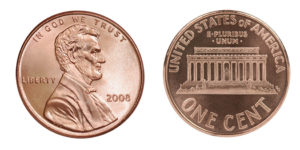
A Pretend Visit
Encourage your child to go on a pretend visit to see relatives. You might:
- Create a car or bus out of a large box.
- Imagine that a playground climbing structure is a boat or plane.
- Pretend a large blanket on the floor is a train.
- Imagine objects to be boat oars or airplane wings.

Daily Message
My aunt is a relative.
- Say the sentence.
- Write the sentence as your child recalls each word.
- Write the letter e below the sentence and tell your child the letter’s name.
- Ask your child to find the letter e in the sentence. Ask: Is there more than one letter e?
- Repeat for the letters r and s.

Writing Together
Talk with your child about air travel. Brainstorm places or relatives that you could visit if you could fly in the air. Have your child complete the sentence stem: I want to fly to see __________ . Write your child’s response on paper and “read” it together as you move your hand under the words.
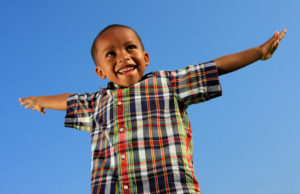
She’ll Be Comin’
Watch the music video “She’ll Be Comin’ Round the Mountain.” Ask: Who do you think is coming around the mountain? (a friend? relative? cousin?) How would you travel around a mountain? Sing and dance along with Don Monopoli.
Storytime
The Best Birthday Party Ever is about celebrating a birthday with a party. Talk with your child about how you celebrate family birthdays (special dinner, sleepover). Point out that relatives often come to parties and even help plan them. Have your child listen to the story to see which relatives help prepare the birthday party.
Leaf Collection
Go on a walk outdoors with your child. Collect leaves from different types of trees. Ask your child to describe the attributes (color, shape, size, texture) of the leaves. Point out that the leaves from one tree look alike, while leaves from another tree may look different. Ask: How are leaves like members of a family?
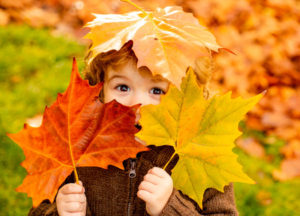
Phone Numbers
Write down your cell phone number. Help your child read the numerals. Write down a relative’s phone number. Help your child read the numerals. Ask: Are any of the numerals the same? Explain: Each 7-digit number is different. Some of the numerals may be the same, but each cell phone has its own unique number. If possible, help your child dial the relative’s number.
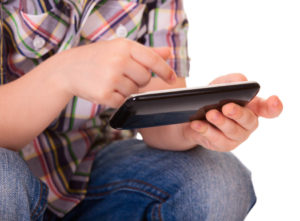
How Many?
Show your child a family photo that includes some relatives. Have your child place a penny (or small rock) on each family member in the photo. Remove the pennies from the photo. Have your child hold up one finger for each penny as you count them. Ask: How many pennies are there?

Commitments
Look at the icons for the four commitments that you and your child have learned: Listening Ears, Walking Feet, Helping Hands, Big Voice. Talk about what each of the commitments means. Encourage your child to choose one of these commitments as a focus for today.

Daily Message
My uncle is a relative.
- Say the message and have your child repeat it.
- Write the message one word at a time.
- Below the message write e and name the letter for your child.
- Have your child say the name of the letter and circle it in the written sentence. Ask: Is there more than one e?
- Repeat for r and s.

My Journal
Talk about where the two of you could go in a boat. Ask: Where would you go? How long would you be gone? Who would go with you? Have your child draw journal pictures about a boat adventure. When the drawing is finished, have your child describe it. Write some words your child says below the drawing.
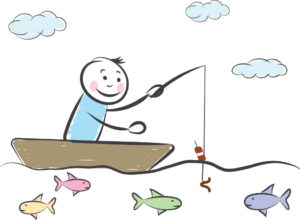
Happy Day
Talk with your child about what a happy day would look like. Explain that “happy” days are different for different people. Dance and move about as you listen to “It’s a Happy Day.” Many of the words in this song are made-up. Ask: What word would you use in a “happy day song?” Click image for lyrics.
Storytime
Watch the read-aloud video The Best Birthday Party Ever with your child. After watching, suggest your child think about what kind of party she would plan for a sibling or a friend. Ask: Who would you ask to help you with the party? What special activities would you plan?
Cake Candles
Invite your child to use play dough or mix dirt with water to make a pretend cake. Have your child place three small sticks on the cake to be candles. Ask: What do the candles on the top of a birthday cake mean? How many candles are on this cake? How many should we put on your cake?
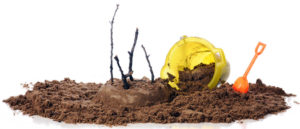
Mark My Birthday
Turn to page 11 in The Best Birthday Party Ever. Talk with your child about the calendar (day and month) where Diego’s sister is marking his birthday (June 5th). Invite your child to find the month and date of her birthday on a yearly calendar. (The calendar on your cell phone or computer will work.)
Leaf Sort
Have your child carefully look at each leaf you collected yesterday. Ask: How could we sort our leaves into groups? What attribute could you use? Could we use the leaves’ color or size? Have your child choose a “sorting rule” and sort the leaves.
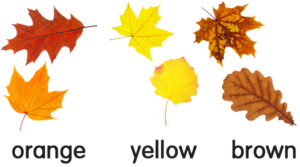
Relatives Work
Talk about different jobs your relatives do. You might say: Aunt Min cooks at a restaurant. Cousin Yen goes to college. Have your child draw a picture of each relative or choose an object (spoon for cook, book for college student) for each. Ask: Which of our relatives do the same kind of work?

Family Handshake
Create a family handshake. Work with your child to think of and combine several moves. For example, you might shake right hands, clap twice, bump fists, and then shake hands again. Practice the handshake with your child. Have your child teach the handshake to other family members.

Daily Message
My cousin is a relative.
- Say the sentence.
- Write the sentence as your child recalls each word.
- Write the letter e below the sentence and tell your child the letter’s name.
- Ask your child to look for the letter e in the sentence. Repeat for the letters r and s.
- Ask: Which letter is in the message only once?

Letter Hunt
Focus Letters: Ee, Rr, Ss
Write each uppercase letter (E, R, S) a note card. Have your child choose one card. Name the letter. Go on a hunt for that letter in your house. When you and your child find it, name the letter: Yes, we found an E. Try finding a different letter. Repeat with lowercase letters (e, r, s).
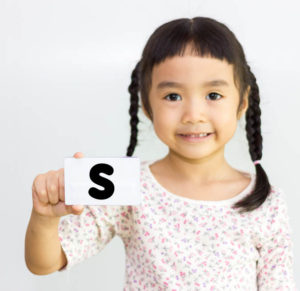
Six on the Bed
Gather six stuffed animals or dolls. As you and your child listen to “Six on the Bed,” act out the story by rolling one animal over and off the bed with each verse. Your child may want to take the place of “the little one” and direct all the others to roll over before pretending to fall asleep. Click image for lyrics.
Storytime
Read Gram Is Coming to My House. Have your child compare the grandmother in this story and in the story Abuela. Ask: Could one of the stories actually happen? Which types of transportation are part of both books? (bus, train, airplane, bike, car, taxi) When Grandma comes to our house, how does she travel?
Pillow Toss
Place a towel in the center of an open area. Ask your child to collect three small pillows or stuffed animals. Standing six feet from the towel, have your child toss each pillow trying to land it on the towel. Ask: How many pillows landed on the towel? Did you need to count or did you just know? Play the game again!
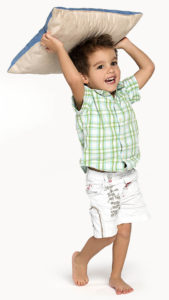
Family Traits
Look at photos of family relatives in a scrapbook, in framed photographs, or online. Decide if the family members in the photos look alike in some ways. They may have the same eye color, mouth shape, or be the same height. Remind your child that just as leaves from the same tree look alike in some ways so do family members. They share “common attributes.”
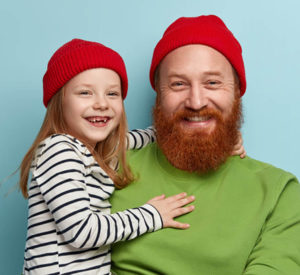
Remote Control
Invite your child to look at the buttons on a television remote control. Demonstrate and talk about how to turn the TV on and off, adjust the volume, and change channels. Ask: What would you like to control? Have your child use markers, scissors, stickers, cardboard, and paper to create a pretend controller. Ask: What does each button do?

How Many Cookies?
Take turns with your child rolling dice inside a box lid. Look at the number of dots on the tops of the dice. Use play dough to make that number of “cookies.” Compare to see which set of cookies has more or fewer. Roll the dice again and make more cookies!
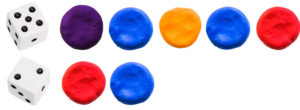
My Family and Friends
Week 3: Pets
This week, you will learn that pets are important family members. They need love and care just like all other family members. You and your child will explore how pets fit into families and how to care for them.
Word of the Week: veterinarian
Before You Begin
Watch this video to better understand the concepts your child will be learning this week. This is not a video you will watch with your child. This is just for you!

Books to Read
- Just Jasper and Me eBook
- Pets Are Family eBook
- Pets Are Family Read-Aloud video
Supplies to Gather
- box
- coins and buttons
- glass
- glue
- ice cube tray
- journal
- markers and crayons
- paper
- paper clips
- pencils
- play dough
- rulers
- scissors
- small rocks
- snack items
- stick-on notes
- stuffed animal
Get Ready
Demonstrate the movements for the song “Get Ready:” Shake both hands in air. Stretch each arm up and across body. Cross to touch elbows to opposite knees. Breathe in through nose. Raise arms. Exhale out mouth. Lower arms. Sing and move to get ready for your day of learning. Click image for lyrics.
Daily Message
Pets need love and care.
- Read the sentence. Place a stick-on note on the table for each word.
- Count the notes. Ask: How many words did we say?
- Write the sentence as your child recalls each word.
- Point out the space you leave after each word.
- Track (move your finger under) the words as you “read” the sentence together. Count the written words.
Storytime
Watch the read-aloud video Pets Are Family with your child. When the video is over, ask: Which pet would you like to have? Help your child make the sign of the pet that she chooses.
Hey, Little Froggie
Invite your child to sing “Hey, Little Froggie.” Remind your child to concentrate while singing the song, making sure to say one counting word: one, two, three for each tap: tap, tap, tap. Explain that the last counting word you say tells you how many taps you made altogether. Click image for lyrics.
Bunny Hop
Have your child crouch like a bunny on the floor. Tell your child to hop forward five hops. Count out loud for each hop. Use a piece of tape to mark how far the “bunny” hopped. Beginning at the same start line, have your child hop five times forward again. Ask: Which set of five hops traveled farthest?
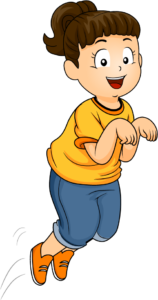
Daily Message
A bird lives in a birdcage.
- Say the sentence and then write it.
- Point to the word birdcage. Explain that birdcage is a compound word. A compound word is two words joined together to make a new word.
- Extend a hand as you say each word: bird and cage. Bring hands together and say: birdcage.

Combining Words
Show page 16 of Pets Are Family. Read the text on the page. Ask your child where fish might live in your home. Click fish image to talk about the compound word fishbowl. Click dog image to see another compound word.
My Dog Rags
“My Dog Rags” is a song about different pets. Invite your child to listen to the song and name the pets. Then play the song again. Have your child pretend to be the animals. Suggest actions by asking questions: How will you make your ears flip-flop? your tail wig-wag? Click image for lyrics.
Storytime
Remind your child about the Table of Contents in Pets Are Family. Say: A Table of Contents helps us find the page we want to read. Turn to the Table of Contents. Read the list of pets. Decide together which pet you want to learn about. Turn to that page and read. Repeat for another pet.
Neighborhood Pets
Walk around your neighborhood with your child. Use your eyes and ears to look for pets. If you own a dog, invite your dog to join you on the walk. Keep track of all the different kinds and sizes of pets on a notepad. Take a few photos with your cell phone. When you return home, count the pets you saw.
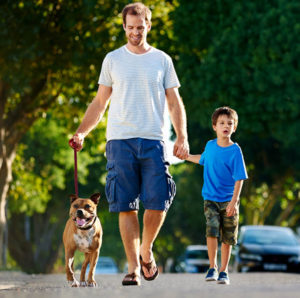
Celebration Ritual
Think of something you want to celebrate, such as receiving a letter from a friend. Share your idea with your child and talk about how you could celebrate. You might read the letter together, call the friend, or do a happy dance. Notice small achievements or moments and celebrate them as part of your routine.
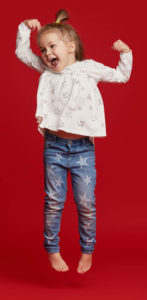
Daily Message
Pet fish live in a fishbowl.
- Say the sentence.
- Write the sentence as your child recalls each word.
- Write the letters a, b, and P on the paper.
- Have your child use a finger to trace the letters, say their names and then find them in the sentence.
- Ask: Is there a compound word in the sentence?
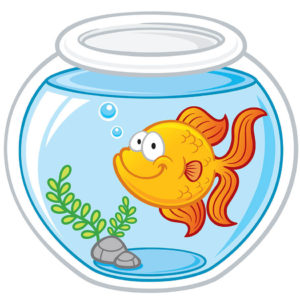
Writing Together
Ask: Do animals eat vegetables? Picture walk through Pets Are Family to find out. Notice that iguanas eat leafy green vegetables (p. 17) and guinea pigs eat lettuce (p. 18). If possible, do a search on the internet to find other pets that eat vegetables. Write down what you discover and then read your sentences together.
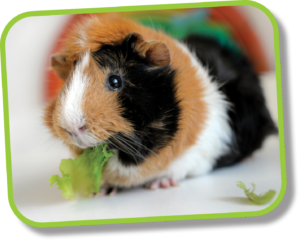
Storytime
Remind your child that the author of a story writes the words and the illustrator draws the pictures. Show the cover of Just Jasper and Me. Read the names of the author and illustrator. Have your child use his own experiences with pets to predict what Jasper and his owner might do in this story. Enjoy reading the story together.
Fill a 5-Frame
Pretend 5 cotton balls are baby chicks. Invite your child to count as she matches one chick to each finger on her hand. Say: The last counting word tells how many. Invite your child to fill a 5-frame, moving left to right, as she counts and places one chick in each hole (nest). Click image to learn how to turn an egg carton into a 5-frame.
Five in a Bag
Place five bottle caps (or other small item) into a small bag. Have your child shake the bag and dump out the bottle caps. Count them together. Put the bottle caps back in the bag. Shake, dump, and count two more times. Ask: Are there still five? Does it matter which one you count first? Explain that an amount does not change when you rearrange the items in the set.
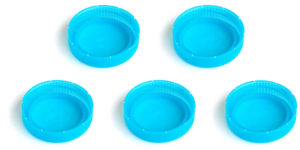
Commitments
Name the four commitments. Talk about what they mean. Have your child choose one commitment for today. Stop at the end of your learning time to check on the commitment. If your child was successful, have her say: I did it! If not, help her choose a specific way to meet the commitment tomorrow. Say: Oops! Time to practice. Tomorrow I will __________ .

Daily Message
Goldfish need clean water.
- Say the sentence and then write it.
- Point to the word Goldfish. Explain that it begins with a capital letter because it is the first word in the sentence.
- Goldfish is a compound word. Say: The words gold and fish go together to make goldfish.

My Journal
Help your child open his journal to the next blank page. Have your child draw pictures of a pet that eats vegetables. Help label the drawing.
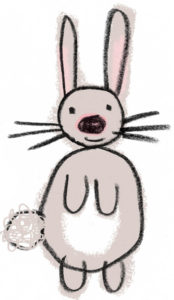
Let’s Celebrate
Earlier this week, you talked with your child about celebrations. Singing “Let’s Celebrate” is one way to honor and celebrate a family member. Have the family member to be honored sit in a decorated chair or on a special pillow. Listen to “Let’s Celebrate” and sing along. Ask the family member: How does it feel to be celebrated? Click image for lyrics.
Storytime
Watch the read-aloud video Pets Are Family with your child. Focus on the hand signs at the end of the video. Help your child do the signs. Then play a simple game. You make the sign and your child pretends to be the animal. Take turns giving a sign and becoming the animal.
Five Rocks
Go on a rock hunt outdoors with your child. Collect exactly five rocks in a plastic bag. Have your child count to be sure there are five in the bag. Back indoors, have your child arrange the rocks inside the egg carton 5-frame you created yesterday. Change the order of the rocks in the 5-frame. Ask: Are there still five? Does the order change the number?
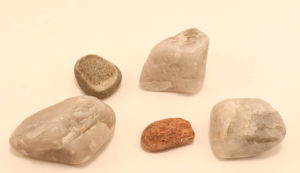
Design a Pet Shelter
Pets (like people) need to be safe and comfortable. Invite your child to consider what materials around the house she could use to create a model of a pet shelter. Ask: How will you put them together to create a shelter? Give your child time for this project. (It may take more than one day.) Click image to show your child rules (design criteria) for the shelter.
Pet Care
Ask: What do you need to be healthy and happy? Pets have similar needs. They can’t live without food, water, and shelter. One of the most important things pets need is someone who loves them. If you have a pet, let your child take the responsibility for a specific part of the pet’s care, such as making sure the water bowl is filled.
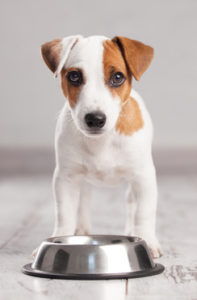
Daily Message
Some dogs sleep in a doghouse.
- Say the sentence and then write it.
- Write the letters a, g, and l below the sentence.
- Have your child use a finger to trace the letters and say their names.
- Have your child find the letters in the sentence.
- Ask: Is there a compound word in the sentence?
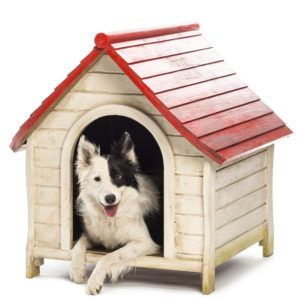
Storytime
Read Just Jasper and Me. As you read the story, point out the pairs of opposite words that are in bold type. Have your child pretend to be Jasper and do the opposite actions, such as rushing inside and outside the house, jumping up to and down from your lap, getting in and out of a wagon.
Here, Little Chick!
Play this hide-and-seek game. Hide five rolled-up socks (baby chicks) in different places around the house. Give your child clues for finding them, such as 1) under the bed, 2) behind your pillow, 3) inside the clothes hamper, 4) on top of the television, and 5) between the lamp and candle. Invite your child to count the chicks.
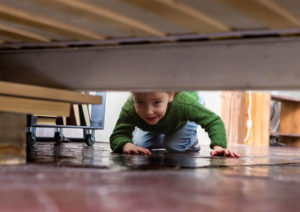
Share Your Design
Gather family members and have your child show and tell about the pet shelter he made with materials found around the house. Ask:
- Why did you choose these materials to make your shelter?
- How did you make your shelter safe? comfortable?
- Did you connect or change materials to build your shelter? How? Why?
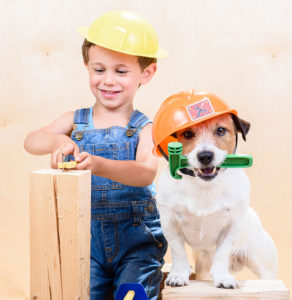
What a Pet Needs
Have your child draw pictures of what a pet needs to show what he has learned this week. Suggest that the pictures could be a list. Show how to start at the top of the page and move toward the bottom. Help label the pictures as needed.

My Family and Friends
Week 4: Friends
This week you and your child will explore friends and friendship. You will think about how friends are alike and different and how to make and keep friends.
Word of the Week: loyal
Before You Begin
Watch this video to better understand the concepts your child will be learning this week. This is not a video you will watch with your child. This is just for you!

Books to Read
- Sara Sidney’s First Day of School eBook
- Yuna and the Paper Cranes eBook
- Yuna and the Paper Cranes Read-Aloud video
Supplies to Gather
- beanbag
- bowl
- bracelet-making materials
- craft sticks
- egg carton
- finger-food snacks (pretzels, crackers, raisins)
- glass of water
- journal
- macaroni pasta or plastic straws
- paper
- pennies
- plastic bag
- plate
- small objects (toys, snack crackers, pebbles, buttons, cereal pieces or blocks)
- stick-on notes
- substances to mix with water (salt, sugar, flour, oil, and sand)
- tape
- writing tools (crayons, markers, pens, pencils)
Good Manners
Explain to your child that when you are polite, you show good manners. For example, you say “please” and “thank you.” You also show good manners when you hold the door open for someone, pick up something someone has dropped, or say “excuse me” when you bump someone. Together think of ways to show good manners around your house.
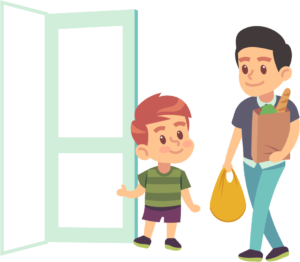
Daily Message
Friends can share __________ .
- Say the sentence. Have your child repeat the sentence.
- Write the sentence as your child recalls the words.
- Point to the blank space at the end of the sentence. Ask your child to fill in the blank. Write your child’s word(s).
- Read the sentence moving your hand under the words. Ask: What other things could you share with a friend?
Vocabulary
Loyal means being faithful, keeping a commitment, and doing what you say. Explain: If you promised to help your friend zip her coat and you did it, you were loyal. If your friend said he would play with you and he did, he was loyal. Have your child think of more examples of being loyal. Click to enlarge the word.
Storytime
Watch the read-aloud video Yuna and the Paper Cranes with your child. The story is about a new girl at school. Encourage your child to respond to the questions the teacher asks as the two of you listen and watch.
Sharing Ten
Have your child help you count ten small objects. You can use pennies, pencils, small toys, or snack crackers. Ask: How many altogether? How can we share these so we each get the same number? If your child does not have a suggestion, give your child one object and then yourself one object. Say: One for you, one for me until all ten are equally shared. Count together to see that you each have five.
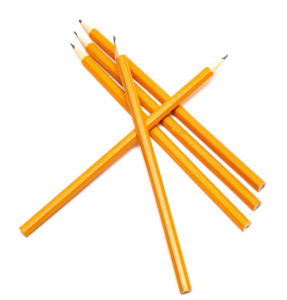
Hide-and-Seek
Gather family members for a game of hide-and-seek. Show how to close your eyes and count out loud to ten. Say “Mississippi” after each number word: One Mississippi, two Mississippi, and so on to ten. Give your child an opportunity to practice counting this way before playing. Have family members take turns being the finder and hiders.

Count to Ten
Have your child spread fingers apart on both hands. Count each finger from one to ten. Spread apart your fingers on both hands. Have your child count each finger to ten just as you did. Wiggle each finger as your child touches and counts it. Switch to the toes and repeat. Take turns counting.
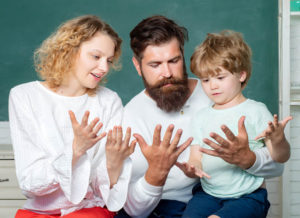
Daily Message
Hannah rang the doorbell.
- Say the sentence. Write it as your child recalls each word.
- Point to doorbell in the sentence. If you have a doorbell, have your child ring it.
- Say: Doorbell is a compound word. Cover the small photo of the door and ask: What is doorbell without door? (bell) Cover the bell and ask: What is doorbell without bell? (door)
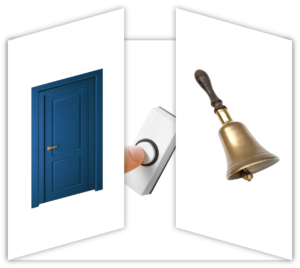
New Friends
Watch the music video “Make New Friends.” Join Don Monopoli and his friends and sing this simple song. Ask: Who do you think all of the people in the video are? What are some of the things you can do to make friends?
Storytime
Look at the cover of Sara Sidney’s First Day of School. Ask: Why is Sara looking at herself in the mirror? Read the book together to remember the story. Ask: Are Sara’s friends in the book new friends or old friends? How could Sara make some new friends?
Mixing
Have your child help you mix a teaspoon of salt into a glass of warm water. Watch what happens. Ask: Can you still see the salt? Why or why not? The salt dissolves (disappears because it mixes so completely) in water. Try the same experiment with a spoonful of sugar or flour. Ask: Do all of the substances mix in the same way? How are they different?

Bracelets
Show your child a favorite bracelet or wristband. Ask questions to help your child think about how the bracelet was made so it fits around a wrist: Why is the bracelet made in the shape of a circle? Does it fit around your wrist? Why, why not? What materials were used to make the bracelet? Do you think it would break easily? Why, why not?

Creating Together
Have your child use crayons or paint to draw on a large piece of paper or cardboard with a sibling or friend. Place the paper on the floor or tape it to a fence outside. Working together will require sharing space and materials. The finished drawing will be a cooperative effort.
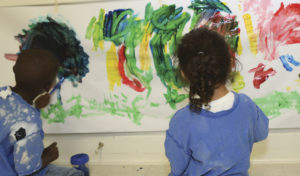
Kindness Tree
Draw the outline of a tree on large paper. Attach the tree to a wall. Have several pre-cut hearts or stick-on notes with a heart drawn on them ready for use. Invite your child to place a heart on the tree outline when someone is kind. At the end of the day, count the hearts.
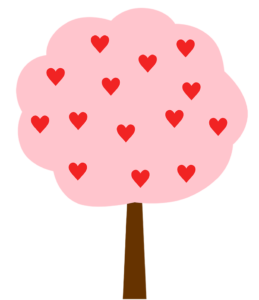
Daily Message
Grandma’s cookies look and smell good.
- Say the sentence as you draw one “cookie” for each word.
- Count the cookies together.
- Write the sentence. Count the words. Compare the number of words and cookies.
- Write c, d, n below the sentence. Say the letter names.
- Have your child find each letter in the sentence.

Writing Together
Talk about sharing. Ask: Why is sharing important to do when you play with friends or siblings? Challenge your child to think of things that are shared every day at home. Write down all of your ideas as a list called “Things We Share.”

Storytime
Read Sara Sidney’s First Day of School. Compare Sara and her best friend Lizzy Camille. Ask: How are they alike and different? Lizzy likes to swing. Sara likes to play on the hammock and slide. They both like swimming and sunning in a nice warm place. After you talk about the story characters, ask: How are you and your best friend alike?
Ten Ways
Place 10 macaroni pasta pieces or 1-inch pieces of plastic straw on a plate. Count the fingers on your hands to show ten altogether. Ask your child to count as she matches each macaroni to one finger on your hands. Invite your child to count again and thread each macaroni onto a string. Name one way you love your child for each macaroni.
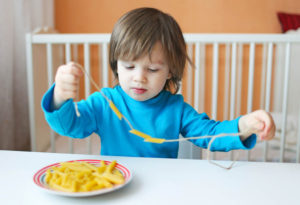
Tic-Tac-Toe
Each player chooses a different set of small objects (pebbles, coins, small blocks) to be her markers. Draw a grid on paper or use craft sticks to make it. Two players take turns placing a marker on the grid. Winner is the player with three in a row: horizontally, vertically, or diagonally. Model what each three-in-a-row looks like on the frame before beginning.
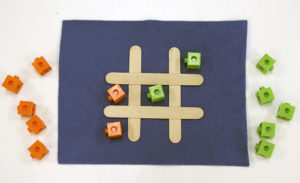
Water, Oil, Sand
Have your child put a spoonful of sand into a glass of water and stir. Ask: What happens to the sand? Where does it go? Why? Say: Sand sinks to the bottom because it is heavier than the water. Have your child add a spoonful of oil to the glass. Ask: What happens to the oil? Where does it go? Say: The oil floats on top.

Daily Message
Who are your school friends?
- Say the sentence and then write it as your child recalls each word.
- Have your child “read” the words with you. Explain that the mark at the end of the sentence is a question mark.
- Have your child point to the question mark and answer the question.
- Write your child’s answer below the question.
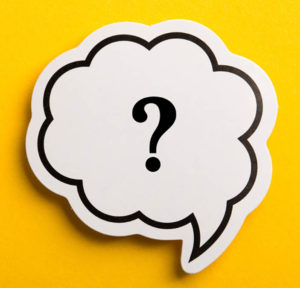
My Journal
Remind your child about Yuna in Yuna and the Paper Cranes. She was new to her classroom and to this country. She didn’t know any one and she didn’t speak English. Have your child draw a picture in her journal about being new to a group. Label the drawing with your child’s words.
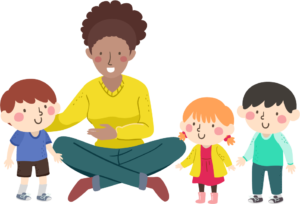
Skip Along
Listen to song “The More We Get Together.” Ask: Do you think that the words in this song are true? Are you happier when you get together with your friends? Why? Sing the song as you skip in a circle. Think of some other movements that go with the music’s rhythm and sing it again. End with a hug! Click image for lyrics.
Storytime
Watch the read-aloud video Yuna and the Paper Cranes with your child. Talk about how the children and teacher welcomed Yuna to her new school. Ask: Would you like to go to Yuna’s school? Why or why not?
Ten-Frame
Cut a 2-by-5 section from an egg carton to make a ten-frame. Invite your child to count the number of sections in each row (5). The five sections in the top row match the number of fingers on your child’s left hand. The five sections in the bottom row match the fingers on the right hand. Count the sections to show there are ten altogether.

Nature Mix
Go outside with your child to collect nature items (leaves, pebbles, sticks, grass, acorns). Have your child predict what would happen if you mixed the collection together in a bowl. Ask: Will they dissolve? stick together? Why or why not? Do the experiment and check your child’s prediction. Together sort the items into small containers or an egg carton for more projects.
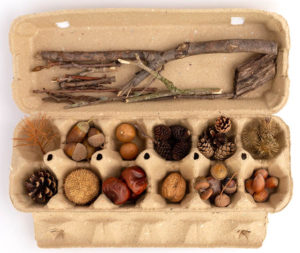
Make It Fancy!
Look at the bracelet-making materials you gathered yesterday. Ask: What materials do we have that would add color? What objects could we attach? How will we attach them? This is an opportunity to recycle or reuse bits of fabric, ribbon, buttons, small plastic lids, or other craft supplies. Encourage creativity.
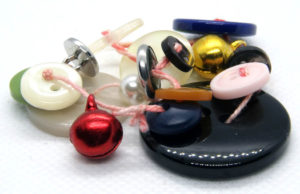
Walk Together
Place two strips of masking tape about 18 inches apart on the floor (or draw chalk lines outside). Have your child walk carefully along one line. Have your child join hands with a sibling and walk the line again. Ask: Is it more difficult to walk the line holding hands or not holding hands? Have your child try to balance a beanbag on her head while walking.
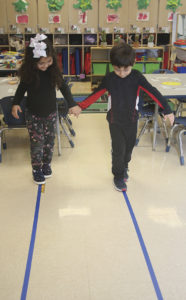
Do You Share?
Challenge your child to problem solve a solution when sharing is required. For example: Dad and Audrey are getting ready to share a sandwich when Gabby walks into the kitchen. What can they do? Should they go ahead and eat, cut the sandwich into smaller pieces, or make a new sandwich? Your situation should reflect your child’s possible experiences.
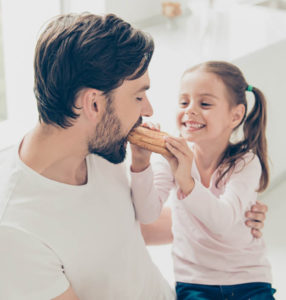
Daily Message
What can you share with friends?
- Read the sentence and then write it.
- Point out the question mark. Have your child answer the question. Write the answer.
- Write the letter c. Name the letter and trace its shape.
- Have your child look for c in the sentence and say the letter name.
- Repeat with the letters d and n.

Musical Circles
Make a circle on the floor with masking tape. Gather your family so you have several players. Have players walk around the circle while you listen to a favorite song. When the music stops, everyone crowds into the circle. The idea is to get everyone inside, so everyone wins. The smaller the circle, the bigger the challenge.

Storytime
Show the cover of Yuna and the Paper Cranes. Remind your child that Yuna can fold paper to make animals. The animals on the cover of the book are cranes. Read the book and find the other origami animals that Yuna makes. Click image to make an origami dog.
Friendship Bracelet
Have your child design a bracelet for a friend. Talk about the types of materials you have discussed this week that would work well for making a bracelet. Encourage your child to think of a particular friend and the kind of bracelet that friend would like. Click image to get started.
Pictures with Ten
Place ten buttons, small blocks, or cereal pieces on the table. Have your child count the ten pieces. Ask: How many are there? Make a happy face with the pieces. Count to show there are still ten. Invite your child to create different arrangements with the same ten pieces. After making each arrangement, count to be sure there are still ten pieces.

Mix a Snack
Divide onto separate plates three different types of finger-food snacks (pretzels, crackers, raisins). There should be ten pieces of each snack. Have your child count to ten as she moves each piece into a plastic bag or bowl. After counting all three snacks into the bag, have your child shake to mix the snacks together. Share and enjoy!
